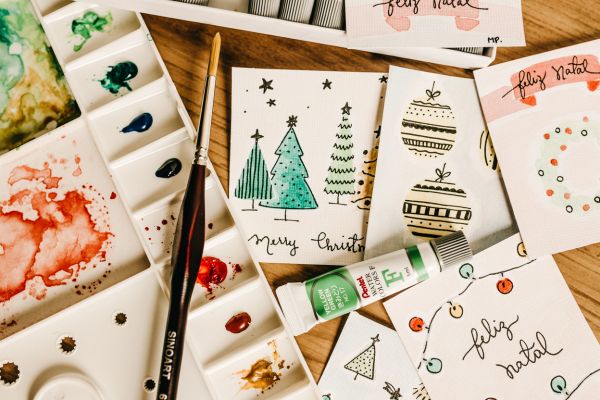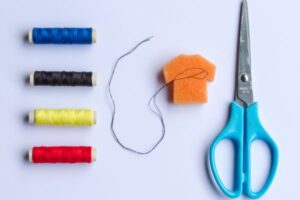Greeting cards are a thoughtful and personalized way to express our sentiments for various occasions, including birthdays, anniversaries, holidays, and special milestones. While store-bought cards are readily available, creating custom greeting cards adds a unique touch and allows us to unleash our creativity. In this comprehensive guide, we will explore the art of designing and creating custom greeting cards. From selecting the right materials and tools to mastering different techniques, you’ll learn how to craft beautiful and meaningful cards that will leave a lasting impression on your loved ones. Whether you’re a seasoned crafter or a beginner, this article will provide you with the knowledge and inspiration to embark on your greeting card-making journey.
Gathering Materials and Tools
Before diving into the creative process, it’s essential to gather the necessary materials and tools for designing and creating custom greeting cards. Start by selecting high-quality cardstock or paper in various colors and textures, ensuring they are compatible with your chosen card-making techniques. Other essential supplies include cutting tools such as scissors, craft knives, or paper trimmers, as well as adhesive options like glue, tape, or adhesive dots. Additionally, consider embellishments such as ribbons, buttons, stickers, and die-cut shapes to add a decorative touch to your cards. Having a well-stocked craft kit will provide you with the flexibility and versatility to bring your card designs to life.
Choosing Card Themes and Occasions
One of the joys of creating custom greeting cards is the ability to tailor them to specific themes and occasions. Start by considering the recipient and the purpose of the card. Is it for a birthday, a wedding, or a holiday? Understanding the occasion will help you determine the appropriate design elements and sentiments to incorporate into your card. Experiment with various themes, from elegant and sophisticated to whimsical and playful, depending on the recipient’s preferences and the nature of the event. Don’t be afraid to think outside the box and explore unique ideas that will make your cards stand out. Remember, the goal is to create a card that resonates with the recipient and captures the spirit of the occasion.
Designing Card Layouts
The layout of your greeting card plays a crucial role in its overall aesthetics and functionality. Consider the size and orientation of your card and how it will open and close. Experiment with different folds, such as side-folds, top-folds, or gate-folds, to add visual interest and create a sense of anticipation. Plan the placement of your design elements, including text, images, and embellishments. Balance is key to creating visually appealing cards, so ensure that your design elements are evenly distributed and harmonize with one another. Sketch out your card layout before assembling it to ensure that everything fits and flows cohesively.
Incorporating Handmade Elements
Handmade elements add a personal and unique touch to your custom greeting cards. Consider incorporating hand-drawn illustrations, watercolor paintings, or calligraphy to infuse your cards with creativity and authenticity. If you’re not confident in your drawing or painting skills, there are various techniques you can explore, such as stamping, embossing, or using stencils. These techniques allow you to create intricate designs and patterns without relying solely on freehand drawing. Experiment with different mediums and techniques to find what works best for you and complements your card designs.
Adding Sentiments and Messages
The sentiment and message you include in your greeting card are just as important as the visual design. Take the time to consider the recipient’s preferences, relationship, and the occasion itself when crafting your message. Keep the tone of your message in line with the overall theme of the card, whether it’s heartfelt and sentimental or lighthearted and humorous. You can handwrite your message directly inside the card or print it on a separate piece of paper or cardstock and adhere it to the card’s interior. Don’t be afraid to let your creativity shine through in your words and convey your heartfelt wishes or meaningful sentiments.
Exploring Different Card-Making Techniques
Designing and creating custom greeting cards offer a vast array of techniques to explore and experiment with. From basic techniques like layering and matting to advanced techniques like embossing, quilling, or paper cutting, each technique adds its own unique flair to your cards. Research and practice different techniques to expand your repertoire and add depth and dimension to your designs. YouTube tutorials, online forums, and craft books are excellent resources to learn and master new techniques. Be open to trying new things and embracing a growth mindset as you embark on your card-making journey.
Incorporating Digital Design Tools
Digital design tools can enhance your card-making process by providing additional creative options and resources. Software programs like Adobe Photoshop or Canva offer a wide range of templates, graphics, and fonts that you can incorporate into your card designs. Use these tools to create digital elements that can be printed and then combined with handmade elements for a unique hybrid approach. Digital tools also allow you to experiment with different color schemes, layouts, and text arrangements before finalizing your designs. Don’t be intimidated by digital design—explore tutorials and online resources to familiarize yourself with the software and unleash your creativity.
Exploring Interactive Card Designs
Interactive card designs take greeting cards to a whole new level by incorporating elements that surprise and engage the recipient. From pop-up cards and slider cards to interactive mechanisms like spinning wheels or pull tabs, these designs add an extra layer of excitement and fun. Research different interactive card designs and experiment with mechanisms that align with your chosen themes and occasions. Be patient and meticulous in assembling these designs, ensuring that the interactive elements function smoothly and without any obstructions. Interactive cards are sure to delight and leave a lasting impression on the recipient.
Personalizing Envelopes and Packaging
The envelope and packaging of your custom greeting cards provide an additional opportunity for personalization and creativity. Consider designing custom envelopes that complement your card designs, whether through matching colors, patterns, or decorative elements. Hand-address the envelopes to add a personal touch or consider using calligraphy or decorative labels for an elegant presentation. Pay attention to the packaging of your cards, especially if you plan to give them as gifts. Explore options like ribbon-tied bundles, decorative boxes, or handmade envelopes to elevate the overall presentation and make your cards even more memorable.
Sharing and Celebrating Your Creations
Once you’ve designed and created your custom greeting cards, it’s time to share and celebrate your creations. Consider showcasing your cards on social media platforms, personal blogs, or local craft fairs to gain recognition and feedback from others. Don’t hesitate to give your cards as gifts to friends, family, or colleagues for special occasions or just to brighten someone’s day. Embrace the joy of card making and continue to refine your skills and techniques. Each card you create is a work of art that reflects your creativity, thoughtfulness, and dedication.
Conclusion
Designing and creating custom greeting cards is a fulfilling and enriching experience that allows you to tap into your creativity, share your emotions, and connect with others in a meaningful way. Throughout this comprehensive guide, we have explored the various aspects of card making, from gathering materials and choosing themes to designing layouts, incorporating handmade elements, and exploring different techniques. We have delved into the world of digital design tools, interactive card designs, and personalizing envelopes and packaging. By following the step-by-step instructions and unleashing your imagination, you have acquired the skills and knowledge to embark on your card-making journey.
The process of designing and creating custom greeting cards is not just about the end result; it is also about the joy of the creative process itself. It is a chance to slow down, express yourself, and infuse your heartfelt sentiments into a tangible piece of art. Whether you create cards for personal use, as gifts for loved ones, or as a small business venture, the act of card making holds a special place in the hearts of both the creator and the recipient.
Remember, there are no strict rules or limitations when it comes to card making. Allow yourself to experiment, take risks, and explore new techniques. Let your creativity flourish and adapt the ideas shared in this guide to suit your personal style and preferences. Each card you create is an expression of your unique perspective, love, and care.
As you continue on your card-making journey, don’t forget to celebrate your creations. Share your cards with others, participate in craft fairs or exhibitions, and embrace the joy of giving your handmade cards as thoughtful gifts. The smile on someone’s face as they receive your card and the appreciation they express for your effort will be immeasurable.
So, gather your supplies, set aside some time for creativity, and let the art of card making bring beauty, joy, and connection into your life. Whether it’s a birthday, a holiday, or a simple gesture of love and friendship, the custom greeting cards you create will have a lasting impact and become cherished keepsakes for years to come.



